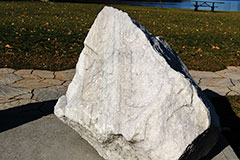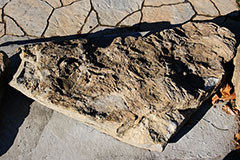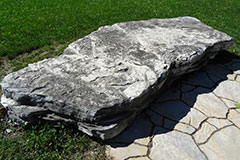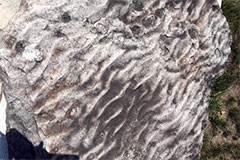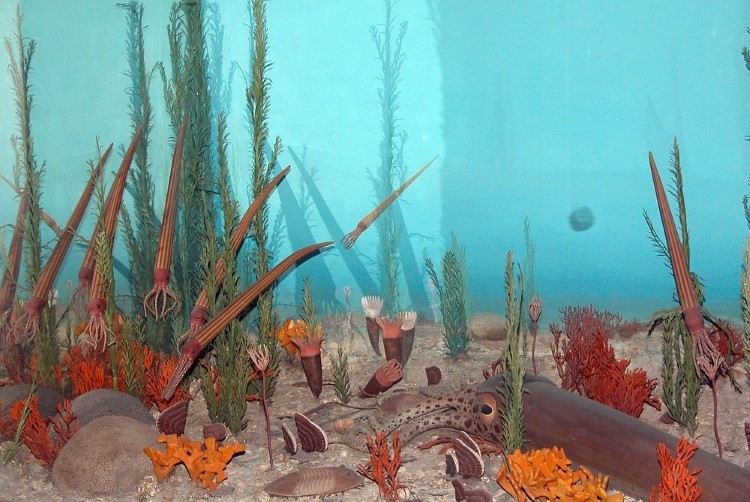What is dolostone?
Dolostone is a sedimentary rock that is composed primarily of the magnesium mineral dolomite, CaMg(CO3)2.

Photo by Brent Eades.
Display rock 19 is dolostone of Ordovician age that was collected locally.
How are dolostones formed?
The formation of dolostone starts with seafloor mud composed largely of calcium carbonate CaCO3. Over millions of years the layers of mud are buried, compressed, and cemented to form sold rock – limestone. The chemical change from limestone to dolostone results from the movement of magnesium-rich groundwater.
Limestones, and thereby dolostones, most commonly form from the sediments of clear, warm, shallow marine waters. These seafloor deposits include particles that are transported from land areas, along with the skeletal remains of marine organisms, such as gastropods (snails), brachiopods (clam-like bivalves), and corals.
Limestone can also be a chemical sedimentary rock formed by the precipitation of calcium carbonate from lake or ocean water.
What to look for.
Note the irregular surface and the indentations, highlighted in pink on the image below. Is this how mud looks when it begins to dry? These features tell us that the water was shallow and occasionally exposed to air, perhaps a tidal zone. This could also be the rumpled appearance of a algal mat covering the seafloor – again suggesting an intertidal zone. The fine, dense crystalline structure of display rock 19 can be seen on the side, along with the fine horizontal laminations that are highlighted on the image below in green. This tells us that the original sediment was very fine grained – like a mud. When a limestone is changed to a dolostone, crystal size often increases, and yet the fine layering of sediment is still preserved in this sample.
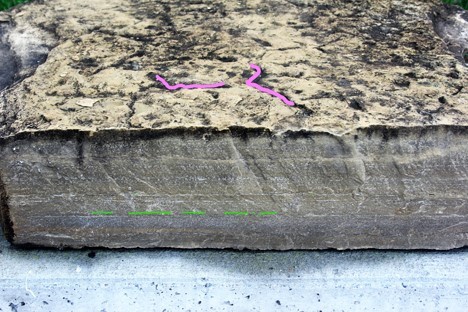
Photo by Julie Lantos.
The subtle features of display rock 19 are clues to its sedimentary formation.
What is a sedimentary environment?
A sedimentary or depositional environment is any area where sediment is capable of accumulating. Sediment can be wind, water and ice borne, and can accumulate both on land (think of deserts) and in water (think lakes, rivers, deltas, beaches, shallow and deep marine). Understanding modern environments of deposition allows geologists to understand the environments in which ancient sedimentary rocks were deposited.

Public domain image by Mikenorton via Wikimedia Commoms.
Why is this important?
By recognizing depositional environments geologists are able to reconstruct the climate and geography of the past and track the enormous changes that have taken place over time.
What do we know about this dolostone?
This rock formed some 450 million years ago, during the Ordovician Period, most likely as a lime mud, in the shallow waters of the Iapetus Ocean. The Iapetus was an Atlantic Ocean precursor that closed during the Devonian Period. It formed over the Canadian Shield on the eroded remnants of the ancient Grenville Mountains chain. There is no evidence of fish from the Ordovician seas that covered our area, but the oceans teemed with life – corals, coralline algae, bryzoans, brachiopods, trilobites, molluscs – to name just a few (see display rocks 13, 15, 16). Organisms that produced calcium carbonate exoskeletons, such as corals and bryzoans, were so numerous that limestones dominate the rock record in Ontario for more than 140 million years, from the Cambrian to the Devonian.
Public domain image of an Ordovician seafloor diorama at the National Museum of Natural History, Washington, D.C., by Fritz Geller-Grimm via Wikimedia Commons.
The Ordovician seas that covered our area were teeming with marine life.
What is dolostone used for?
Dolostone and limestone are used in similar ways. They are crushed and used as an aggregate in construction projects. They are kiln-fired in the manufacture of cement. They are cut into blocks and slabs for use as a dimension stone. Dolostone is often preferred as its greater hardness makes it a superior construction material and its lower solubility makes it more resistant to the acid content of rain. Dolostone is also used as a soil conditioner and as a feed additive for livestock.
Dolostone and Dolomite
Dolostone is common in the rock record, and yet the mineral dolomite, named after the French Geologist Déodat de Dolomieu (1750 –1801), is rarely observed forming in sedimentary environments. For this reason it is believed that most dolostones form when lime muds or limestones, (composed largely of the calcium carbonate mineral calcite, CaCO3), are chemically changed by magnesium-rich groundwater.
Dolostone is slightly harder than limestone, at 3.5 to 4 on the Mohs scale of hardness. Limestone, composed of the softer mineral calcite, has a hardness of 3. Dolostone is slightly less soluble in dilute hydrochloric acid. Calcite will effervesce vigorously in contact with cold, dilute (5%) hydrochloric acid, while dolomite produces a very weak effervescence.
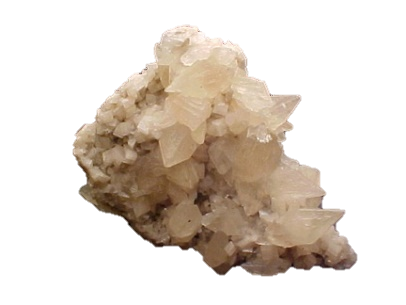
Public domain image by Michael P. Klimetz via Wikimedia Commons.
This mineral sample includes smaller crystals of dolomite and larger crystals of calcite.
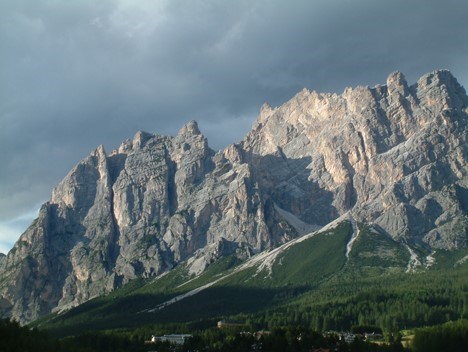
Public domain photo by I Andrew via Wikimedia Commons.
The Dolomites are mountains near Cortina d’Ampezzo, a popular winter sport resort in the province of Belluno, Veneto, northern Italy.
Where are these rocks forming today?
Young limestones are being formed all over the world, where the water is clear and warm. The Great Barrier Reef of Australia, and the Great Bahama Bank are both modern examples.
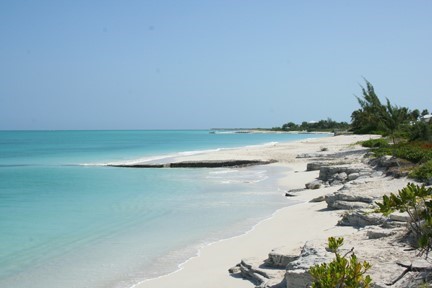
Photo by Julie Lantos.
In this picture from Turks and Caicos, the limestone rock seen on the right is just a few thousand years’ old – a baby in geological terms. The carbonate sand on the beach and under the water may someday become rock too.

